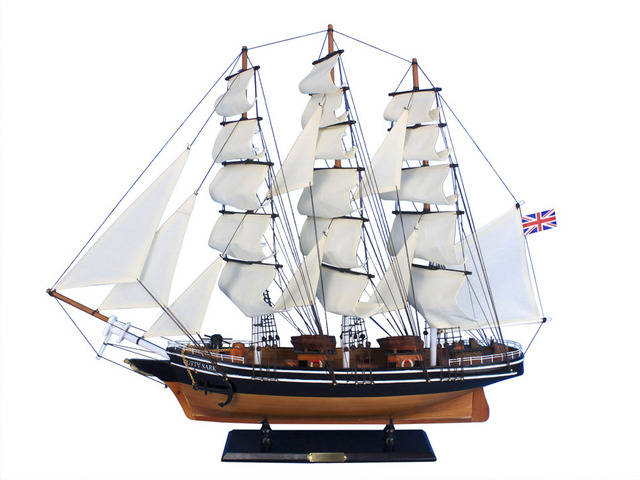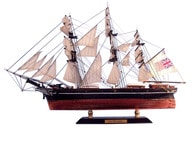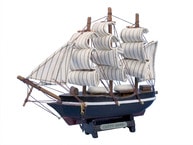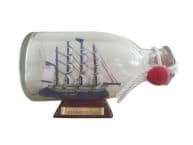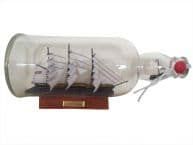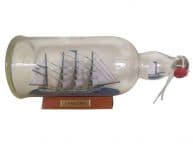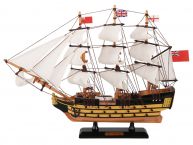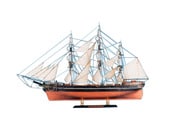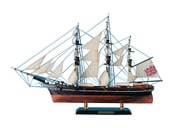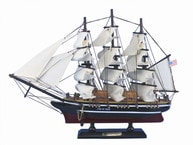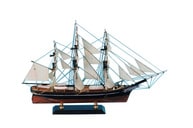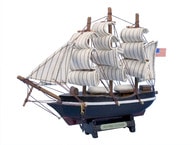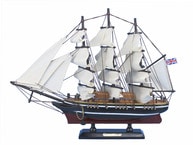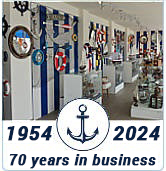Handcrafted Model Ships customers also shopped

|
|

|
Wooden Cutty Sark Tall Model Clipper Ship 30"
The Cutty Sark is a clipper ship. Built in 1869, she served as a merchant vessel (the last clipper to be built for that purpose), and then as a training ship until being put on public display in 1954. She is preserved in dry dock at Greenwich in London, but was damaged in a fire on May 21, 2007 while undergoing extensive restoration.
Etymology
The ship is named after the cutty sark (Scots: a short chemise or undergarment). This was the nickname of the fictional character Nannie (also the name of the ship's figurehead) in Robert Burns' 1791 comic poem Tam o' Shanter. She was wearing a linen cutty sark that she had been given as a child, therefore it was far too small for her. The erotic sight of her dancing in such a short undergarment caused Tam to cry out "Weel done, Cutty-sark", which subsequently became a well known idiom.
History
She was designed by Hercules Linton and built in 1869 at Dumbarton, Scotland, by the firm of Scott & Linton, for Captain John "Jock" "White Hat" Willis; Scott & Linton was liquidated, and she was launched November 22nd of that year by William Denny & Brothers.
Cutty Sark was destined for the tea trade, then an intensely competitive race across the globe from China to London, with immense profits to the ship to arrive with the first tea of the year. However, she did not distinguish herself; in the most famous race, against Thermopylae in 1872, both ships left Shanghai together on June 18th, but two weeks later Cutty Sark lost her rudder after passing through the Sunda Strait, and arrived in London on October 18th, a week after Thermopylae, a total passage of 122 days. Her legendary reputation is supported by the fact that her captain chose to continue this race with an improvised rudder instead of putting into port for a replacement, yet was only beaten by one week.
In the end, clippers lost out to steamships, which could pass through the recently-opened Suez Canal and deliver goods more reliably, if not quite so quickly, which proved to be better for business. Cutty Sark was then used on the Australian wool trade. Under the respected Captain Richard Woodget, she did very well, posting Australia-to-Britain times of as little as 67 days. Her best run, 360 nautical miles (666 km) in 24 hours (an average 15 kn (28 km/h), was said to have been the fastest of any ship of her size.
In 1895 Willis sold her to the Portuguese firm Ferreira and she was renamed Ferreira after the firm, although her crews referred to her as Pequena Camisola ("little shirt", a straight translation of the Scots "cutty sark"). In 1916 she was dismasted off the Cape of Good Hope, sold, re-rigged in Cape Town as a barquentine, and renamed Maria do Amparo. In 1922 she was bought by Captain Wilfred Dowman, who restored her to her original appearance and used her as a stationary training ship. In 1954 she was moved to a custom-built dry-dock at Greenwich.
Cutty Sark is also preserved in literature in Hart Crane's long poem "The Bridge" which was published in 1930.
Museum ship
The Cutty Sark was preserved as a museum ship and popular tourist attraction. She is located near the centre of Greenwich, in south-east London, close aboard the National Maritime Museum, the former Greenwich Hospital, and Greenwich Park. She is also a prominent landmark on the route of the London Marathon. She usually flies signal flags from her ensign halyard reading "JKWS", which is the code representing Cutty Sark in the International Code of Signals, introduced in 1857.
The ship is in the care of the Cutty Sark Trust, whose president, the Duke of Edinburgh, was instrumental in ensuring her preservation, when he set up the Cutty Sark Society in 1951. The Trust replaced the Society in 2000. She is a Grade I listed monument and is on the Buildings At Risk Register.
Cutty Sark station on the Docklands Light Railway is one minute's walk away, with connections to central London and the London Underground. Greenwich Pier is next to the ship, and is served by scheduled river boats from piers in central London. A tourist information office stands to the east of the ship.
Conservation and fire
On the morning of May 21, 2007 the Cutty Sark, which had been closed and partly dismantled for conservation work, caught fire, and burned for several hours before the London Fire Brigade could bring the fire under control. Initial reports indicated that the damage was extensive, with most of the wooden structure in the centre having been lost.
In an interview the next day, Richard Doughty, the chief executive of the Cutty Sark Trust revealed that at least half of the "fabric" (timbers, etc) of the ship had not been on site as it had been removed during the preservation work. Doughty expressed that the trust was most worried about the state of iron framework to which the fabric was attached. He did not know how much more the ship would cost to restore, but estimated it at an additional £5–10 million, bringing the total cost of the ship's restoration to £30–35 million.
The cause of the fire is as yet unconfirmed. After initial analysis of the CCTV footage of the area suggested the possibility of arson, further investigation over the following days by Scotland Yard failed to find conclusive proof that the fire was set deliberately. A full report is due to be released in the summer of 2008.
Aerial video footage showed extensive damage, but seemed to indicate that the ship had not been destroyed in its entirety. A fire officer present at the scene said in a BBC interview that when they arrived, there had been "a well-developed fire throughout the ship". The bow section looked to be relatively unscathed and the stern also appeared to have survived without major damage. The fire seemed to have been concentrated in the centre of the ship. The chairman of Cutty Sark Enterprises said after inspecting the site: "The decks are unsalvageable but around 50% of the planking had already been removed; however, the damage is not as bad as originally expected."
As part of the restoration work planned before the fire, it was proposed that the ship be raised three metres, to allow the construction of a state of the art museum space beneath. This would allow visitors to view her from below.
For a long time, there had been growing criticism of the policies of the Cutty Sark Trust and its stance that the most important thing was to preserve as much as possible of the original fabric. The fire damage has been put forth as a reason for the Cutty Sark to be rebuilt in a manner that would allow her to put to sea again by proponents of the idea. However, the Cutty Sark Trust have found that less than 5% of the original fabric was lost in the fire, as the decks which were destroyed were non-original additions. There are currently two petitions to the UK Prime Minister, one for funds to restore the ship, and the other for funds to restore the ship into commission as a sail training vessel.
In addition to explaining how and why the ship is being saved, the exhibition features a new film presentation, a re-creation of the master's saloon, and interactive exhibits about the project. Live webcam views of the conservation work allow the visitor to see remotely the work being carried out on the ship.
The design for the renovation project by Youmeheshe architects with Grimshaw architects and Buro Happold engineers involves raising the ship out of her dry berth using a Kevlar web, allowing visitors to pass under the hull.
Oscar-winning producer Jerry Bruckheimer has aided in the repair and restoration of the Cutty Sark. A collection of photos taken by Bruckheimer went on display in London in November 2007 to help raise money for the Cutty Sark Conservation Project. The exhibition featured more than thirty pictures taken on set during the filming of Pirates of the Caribbean: At World's End
In January 2008 the Heritage Lottery Fund awarded the Cutty Sark Trust another £10 million towards the restoration of the ship, meaning that the Trust had now achieved £30 million of the £35 million needed for the completion of the project.
In June 2008, Israeli shipping magnate Sammy Ofer donated the final £3.3 million need to fully restore the ship.
General specifications
The Cutty Sark is one of only three surviving ships of its time that has a composite wrought iron frame structure covered by wooden planking. The hull has a Muntz metal coating.
* Tonnage: 921 tons (2,608 m³)
* Hull length: 212.5 ft (64.8 m)
* Beam: 36 ft (11 m)
* Draft: 21 ft (6.4 m)
Yard lengths (after being cut down in Sydney harbour):
* Fore
o fore course 21.0 yd (19.2 m)
o lower topsail 16.8 yd (15.4 m)
o upper topsail 14.6 yd (13.4 m)
o topgallant 11.5 yd (10.5 m)
o royal 9.4 yd (8.6 m)
* Main
o main course 21.6 yd (19.8 m)
o lower topsail 18.5 yd (16.9 m)
o upper topsail 16.8 yd (15.4 m)
o topgallant 14.2 yd (13.0 m)
o royal 10.4 yd (9.5 m)
* Mizzen
o mizzen course 17.4 yd (15.9 m)
o lower topsail 14.9 yd (13.6 m)
o upper topsail 13.4 yd (12.3 m)
o topgallant 11.0 yd (10.1 m)
o royal 8.2 yd (7.5 m)
o spanker 14.1 yd (12.9 m)
References in popular culture
Cutty Sark inspired the name of a brand of whisky. An image of the ship appears on the label, and the maker formerly sponsored the Cutty Sark Tall Ships' Race. She also inspired the name of the Saunders Roe Cutty Sark flying boat. The Life and Times of Scrooge McDuck part three-and-a-half: The Cowboy Captain of the Cutty Sark by Don Rosa features the ship herself. In the award winning science fiction novel Blue Mars, by Kim Stanley Robinson, the Cutty Sark is portrayed sailing in one of the newly created channels on Earth following a major flood bought upon by volcanic activity in Antarctica. In The Deptford Mice trilogy of books by Robin Jarvis, the mouse character Thomas Triton lives on board the Cutty Sark. Cutty Sark is also mentioned in the song "Single Handed Sailor", performed by Dire Straits.
On Thursday May 24, 2007, Jonathan Ross revealed that he had missed the recent BAFTAs and failed to pick up his award because he was on a family trip to Cutty Sark. The comments were aired the next day as part of the Jonathan Ross show. A joke was also made as though it was Jonathan himself who burnt down the Cutty Sark.
The following day, during an episode of Have I Got News for You, Paul Merton kept insisting that the Duke of Edinburgh had burnt down the ship, an allusion to the conspiracy theory that the duke was involved in the death of Diana, Princess of Wales. The much-publicised inquest into her death was approaching at this time.
Slightly more obscurely, the magazine of the University of Greenwich student union - the main campus of which is immediately next to the ship, comprising the majority of buildings of the Royal Naval College - is also named after the ship; the Sarky Cutt.
Journalist Robert Fisk's grandfather was a first-mate aboard the Cutty Sark and mentioned in The Great War for Civilisation: The Conquest of the Middle East.





 Handcrafted Beach Décor
Handcrafted Beach Décor



